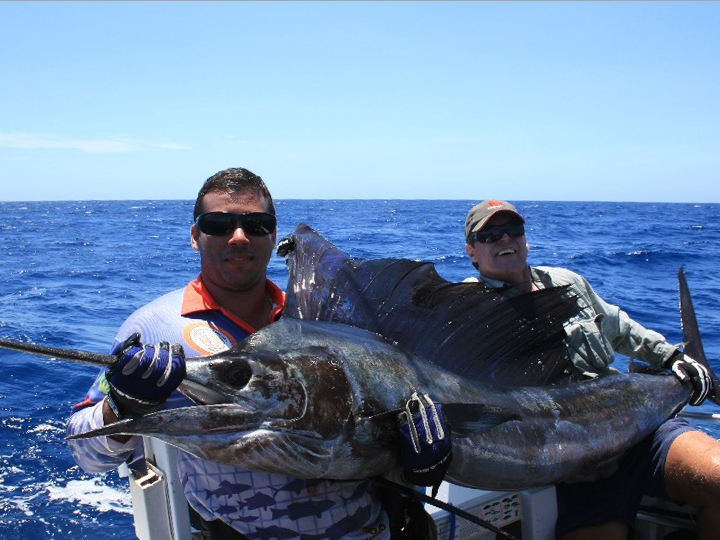Sailfish and Swordfish are two of the most awe-inspiring fish you’ll ever see. Widely recognized as apex predators, the two Billfish are prized game species for recreational anglers. But with lean, muscular bodies and long prominent bills, these marine big shots can look pretty similar. That begs the question: how can you tell if it’s a Sailfish vs. Swordfish? That’s exactly what you’re going to find out today.

Distribution and Habitat
Sailfish and Swordfish are fairly widespread species, native to temperate waters of the Atlantic, Pacific, and Indian Oceans. They’re both pelagic fish, meaning that they swim throughout the water column, but almost never at the bottom of the sea.
And while Sailfish keep to waters between 70°F and 83°F, Swordfish tolerate a much wider range of temperatures. You can find them in waters ranging anywhere between 41°F and 81°F. Fun fact: Swordfish have an organ inside their heads that heats their eyes and brain, allowing them to hunt even in extremely cold waters!

Compared to Sailfish, Swordfish don’t just tolerate colder waters, they swim in much deeper parts of the sea, too. While Sailfish can navigate waters up to 660 feet deep, Swordfish regularly dive to depths of 1,800 feet!
Behavior
Swordfish are solitary fish, mostly keeping to themselves. Unlike most fish, they like to hunt at night. This is why, up until a decade or so ago, anglers almost exclusively went after Swords after nightfall. However, in recent years, thrill-seeking anglers discovered that daytime swordfishing can be just as productive.

Sailfish, too, are mostly solitary fish, but they’re not absolute loners like their cousins. When searching for prey, Sails will often “school-up” to hunt together. Their “herding” tactics are nothing short of ingenious.
Using bumping and slashing motions, Sailfish use their sharp bills to direct schools of prey. Even more impressive, they shift their colors to communicate their intentions, thus coordinating their attack with surgical precision. And that’s not all. Sails are lightning fast, too. Widely considered as the fastest fish in the ocean, these guys clock in at an astounding 68 miles per hour!
Appearance
Despite their similar looks, Sailfish and Swordfish boast a few distinct physical differences.

Shape and Size
Swordfish are a lot bigger than Sailfish, and this is one of the main differences between the two. Also, while the body of a Swordfish is usually cylindrical, the body of a Sailfish is laterally compressed.
Sailfish typically grow to 120 inches in length (couting the bill). Depending on whether they’re native to the Atlantic or the Indo-Pacific, they’ll weigh around 120 or 200 pounds max. For an average angler, however, a Sail ranging from 40–60 pounds is most common.

A Swordfish, on the other hand, will easily top 130 inches. Compared to Sailfish, they’re a lot bulkier, too. This allows them to easily reach sizes of 220 pounds or more. In fact, the largest Swordfish ever caught weighed a whopping 1,430 pounds!
Fins
But what if you come upon what looks like a juvenile Swordfish? In that case, look no further than its fins.
Sailfish boast a long dorsal fin that runs almost the entire length of their frame. When extended, the fin becomes wider than the entire body, forming what looks like a sail (hence the name). The dorsal fin on a Swordfish, however, is a slim, crescent-shaped appendage, which never changes its shape.

Other
The differences between Sailfish and Swordfish don’t stop there. The two fish are different in a few other ways that are a little tougher to spot, but are useful to know all the same.
Unlike Sailfish, adult Swordfish have no teeth or scales. As they mature, Swordfish lose their scales, which give way to smooth, uniform skin. The bill on a Sailfish is thin, spanning around a fourth of the length of the body. On a Swordfish, the bill is longer and thicker, reaching almost half of the length of the body.
Last but not least, the eyes on a Swordfish are much bigger than on a Sailfish. Because they swim in deeper and darker waters, Swordfish need to have superior vision. Larger eyes allow them to absorb a lot more light than other Billfish.
How to Catch Them
Sailfish often come close to the surface of the water, which makes them a perfect target for trolling. They are an amazing light tackle catch, often awarding your efforts with spectacular aerial acrobatics. If you’re up for a challenge, try hooking these monsters with a fly rod!

For Swordfish, deepwater drifting with natural bait is the way to go. These beasts are extremely powerful, and they typically require much heavier gear to land. Most anglers still target Swordfish at night, but as we mentioned, daytime fishing can be just as productive.
Sailfish and Swordfish are two incredible Billfish, each fascinating in their own way. Now that you know how to tell Sailfish and Swordfish apart, there’s nothing to stop you from catching one!
So there you have it. Those were the differences between Sailfish and Swordfish. What’s your favorite thing about these two fish? Are there any differences you think we might have missed? Let us know in the comments below.